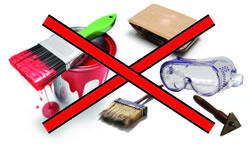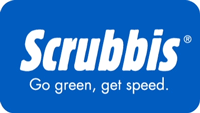The main reason for using hull paint and anti-fouling on the boat hull is to prevent sea plants and marine growth from attaching and growing on the hull. Fouling on the hull creates friction in the water which makes the boat slow down and increases its fuel consumption. The various motions that the bottom of the boat counteract are different types of algae, seaweed, barnacles, shells etc. For this to work, the hull paint must contain “toxic” substances for the environment. The various harmful substances for the environment throughout the ages have been TBT, copper and other heavy metals.
There are different recommendations on bottom paint in different waters (sea/coast/lake). Usually the hull paints contain different amounts of heavy metals.
At the time of writing there are NO non-toxic hull paints that work 100% against hull fouling.
Layer of mucus despite hull paint
Even though the boat hull is painted with hull paint and does not have any fouling on the hull, it grows a thin layer of mucus on the hull. The mucus layer creates small whirls in the flow, which in turn increases the friction between the boat and the water. This also reduces speed and increases the fuel consumption. Mucus layers can only be mechanically removed and no chemicals or hull paints can prevent it. The mucus layer sits very loose when the boat is in the water and therefore very easy to remove with your hand or with a brush. But as soon as the boat is lifted above the water surface and the mucus comes in contact with air, a hardening process begins, which makes it much harder to remove.
Recreational boats go approximately 10-30% slower at the end of the boating season compared to the start of the season. The fuel consumption also increases with up to 20%. This is due to fouling and/or mucus layer on the boat hull.
Don’t use toxic hull paint and anti-fouling!
You don’t have to use any hull paint on the hull of your boat! Instead of toxic anti-fouling, mechanical removal of fouling can be used. This applies to all types of recreational boats, sailboats and motorboats. No matter what material you have on your hull, plastic, metal, aluminum or wood. What you need to do with some boat types is to paint with a “regular” hard paint that doesn’t contain “toxins” or heavy metals. This clogs the pores in the hull so that it doesn’t absorb liquid and also makes it look nice.
Hull paints for Scrubbis-users

To protect the environment, we recommend that you coat the hull with a regular hard and smooth paint. Preferably free from biocides and other toxins. This way the pores in the hull are clogged so that it doesn’t absorb water and the surface of the hull becomes smooth and easy to clean.
Suitable non-toxic hull paints that can today be found on the market and that are suited for mechanical cleaning are often based on silicon or epoxy.
Talk to your paint distributor for the best recommendation for your specific hull, preferably without any “toxin” or heavy metals.
Alternatives to hull paint and anti-fouling
There are several alternatives to boat hull paints that either prevents or removes fouling. Among the alternatives are brush washers, canvas, lifts and airless sprays, etc.
But the absolutely best, most effective and cheapest option in our would is Scrubbis!
With SCRUBBIS Hull Scraper SET you can easily remove barnacles, algae and other fouling from the boat hull. You clean the hull yourself while the boat is still in the water.
SCRUBBIS Hull Scraper SET is a cleaning tool that is developed to be gentle to the boat hull while at the same time an effective tool to remove fouling from the hull. The cleaning head has a built-in buoyance at 2 kg that pushes against the hull.


